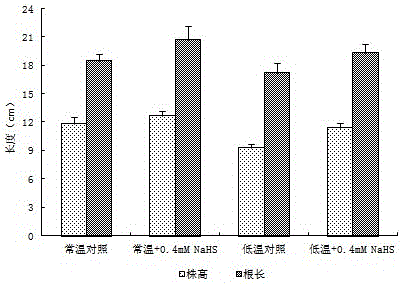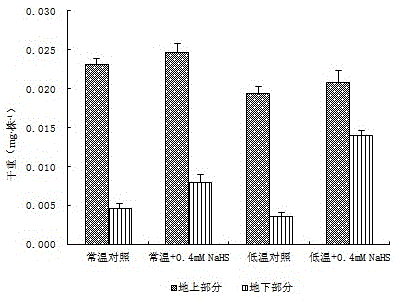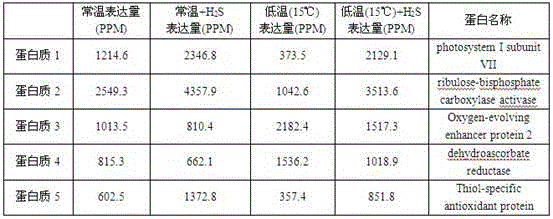Application of hydrogen sulfide and hydrogen sulfide donor in preparation of rice seed induction cold-resistant sprout-promoting fertilizer
A hydrogen sulfide donor and rice seed technology, which is applied in the field of hydrogen sulfide to achieve the effects of promoting oxidative decomposition, increasing germination potential and increasing germination rate
- Summary
- Abstract
- Description
- Claims
- Application Information
AI Technical Summary
Problems solved by technology
Method used
Image
Examples
Embodiment 1
[0021] Example 1 Experiment of promoting the germination of rice seeds in low temperature environment by sodium hydrosulfide
[0022] Weigh sodium hydrosulfide monohydrate (NaHS·H 2 O) Add water to prepare a 0.4 mmol / L sodium hydrosulfide aqueous solution. Experimental group: Pretreat rice seeds in a 0.4 mmol / L sodium hydrosulfide (NaHS) aqueous solution (soaking, the same below) at room temperature for 12-24 hours, and set 3 groups in parallel; at the same time set up a control group: That is, rice seeds are pretreated (soaked, the same below) for 12-24 hours in a solvent aqueous solution without sodium hydrosulfide (NaHS) at room temperature. Then, the seeds of the experimental group and the control group were taken out and sown at low temperature conditions of 10°C. The experimental results showed that the germination rate of rice seeds in the experimental group that were pretreated with 0.4 mmol / L sodium hydrosulfide (NaHS) aqueous solution was 33% ~ 41% higher than that of ...
Embodiment 2
[0023] Example 2 Experiment of Sodium Hydrosulfide Promoting the Growth and Development of Rice Seedlings in a Low Temperature and Chilling Injury Environment
[0024] 1. Experimental method: Weigh sodium hydrosulfide monohydrate (NaHS·H 2 O) Add water to prepare 0.4mmol / L concentration aqueous solution. Experimental group: The rice seedlings in the one-leaf and one-heart stage were moved into a low temperature environment of 15°C, watered with a sodium hydrosulfide (NaHS) solution with a concentration of 0.4mmol / L, watered every 24 hours, treated for 6 times and then sampled and recorded, parallel Set 3 groups. At the same time, a control group was set up: the rice seedlings in the one-leaf and one-heart stage were moved into a low-temperature environment of 15°C, watered only once every 24 hours, and recorded after 6 treatments.
[0025] 2. Experimental results. Such as figure 1 with figure 2 As shown, 0.4mmol / L NaHS aqueous solution can obviously alleviate the stress of low...
Embodiment 3
[0026] Example 3 Experiment of Sodium Hydrosulfide Promoting Protein Expression in Rice Seedling Leaves in Low Temperature and Chilling Injury Environment
[0027] 1. Experimental method: Weigh sodium hydrosulfide monohydrate (NaHS·H 2 O) Add water to prepare 0.4mmol / L concentration aqueous solution. Experimental group: The rice seedlings in the one-leaf and one-heart stage were moved into a low temperature environment of 15°C, and were irrigated with a 0.4mmol / L sodium hydrosulfide (NaHS) aqueous solution every 24 hours. Three groups were set in parallel. At the same time, a control group was set: the rice seedlings in the one-leaf and one-heart stage were moved to a low temperature environment of 15°C, and watered only once every 24 hours. After 48 hours of treatment, the leaves of the seedlings were taken to extract protein, and the protein was determined in each experimental group. The amount of expression.
[0028] 2. Experimental results.
[0029] The specific experimenta...
PUM
 Login to View More
Login to View More Abstract
Description
Claims
Application Information
 Login to View More
Login to View More - R&D
- Intellectual Property
- Life Sciences
- Materials
- Tech Scout
- Unparalleled Data Quality
- Higher Quality Content
- 60% Fewer Hallucinations
Browse by: Latest US Patents, China's latest patents, Technical Efficacy Thesaurus, Application Domain, Technology Topic, Popular Technical Reports.
© 2025 PatSnap. All rights reserved.Legal|Privacy policy|Modern Slavery Act Transparency Statement|Sitemap|About US| Contact US: help@patsnap.com



